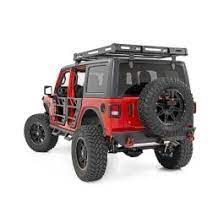Specialised racks made for mounting on the roof of a 4×4 vehicle are known as 4×4 roof racks. For gear and equipment that might not fit inside the car or in other storage spaces, these racks offer extra storage space.
It is however important to note the several different kinds of 4×4 roof racks available on the market. They include:
1. Flat platforms that may be connected to the roof of a 4×4 vehicle, better known as platform roof racks. They can be adjusted to meet certain demands and provide a ton of room for gear and equipment.
2. Basket roof racks: They resemble platform racks but have a raised edge to stop cargo from falling off. They are perfect for transporting bulkier objects that may not fit on a platform rack.
3. Cargo boxes: A 4×4’s roof can be equipped with these enclosed containers. They can be used to transport equipment that has to stay dry and provide protection from the weather.
4. Bike racks: They are made to transport bicycles on a 4×4 roof. They may be tailored to accommodate many bike models and can hold several bikes at once.
To select the best 4×4 roof rack for your vehicle and your unique demands, you must carefully evaluate several factors.
1. Identify the primary function of the roof rack, such as hauling tools, sporting equipment, or camping supplies. This will assist you in selecting a rack that matches your unique requirements.
2. Vehicle compatibility: Verify that the roof rack you select is appropriate for the brand and model of your car. Check the installation advice and guidelines provided by the manufacturer.
3. Load capacity: Take into account the roof rack’s load capacity
4. Size and dimensions: To make sure the roof rack fits correctly on your car, take into account the roof rack’s size and measurements. To determine the maximum size of the roof rack, measure the roof of your car.
5. Material: Choose a roof rack made of strong and lightweight materials, such as composite, steel, or aluminium. This will guarantee that it can resist challenging weights and bad weather.
6. Aerodynamics: Take into account the roof rack’s aerodynamics to lessen wind resistance and noise when driving. Choose a design that reduces turbulence and wind drag.
7. Budget: Before buying a roof rack, ascertain your spending limit and search for models that provide the best value.
Mounting
Even though installing 4×4 racks that hold over 100kgs on a vehicle may seem difficult, you can do it by following these general guidelines:
1. Make the roof ready: To ensure that the roof rack fits securely, thoroughly clean the vehicle’s roof of any dirt or debris.
2. Measure the roof: To decide the largest roof rack you can install, measure the roof of your car. Measure the distance between the roof rails or mounting points using a tape measure.
3. Positioning the roof rack: Place the roof rack on top of your car’s roof, aligning it with the mounting points or roof rails. Ensure that the roof rack is level and centred.
4. Mount the roof rack: Mount the roof rack to the roof rails or mounting points using the provided hardware. To make sure the roof rack is firmly fastened to the car, tighten the bolts or screws.
5. Check the rack: Gently shake the roof rack to make sure it is firmly fastened to the car. Verify if the roof rack’s maximum load can support the weight of your equipment.
6. Fine-tune and adjust the roof rack: Make any necessary modifications to the roof rack, such as tightening bolts or relocating the crossbars, to ensure it is stable.

